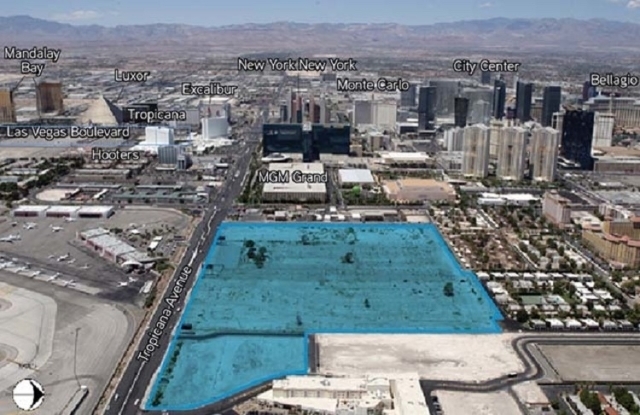UNLV group strikes deal to buy 42-acre site for stadium, other uses

The UNLV Foundation, the university’s nonprofit fundraising arm, has entered a deal with Wells Fargo to buy a 42-acre site at Koval Lane and Tropicana Avenue for $50 million for a potential football stadium or other uses.
The UNLV Foundation won’t actually close on the land deal but instead transfer the option on the property to UNLV, or the university and other private partners, to cover the entire $50 million purchase, said Gerry Bomotti, senior vice president for finance and business.
The Board of Regents would have to approve any land purchase.
“The agreement is, essentially, a purchase and sale agreement, but with an option until we clear all due diligence items. The terms of the purchase have been negotiated and are part of the agreement with Wells,” Bomotti said. UNLV has until Dec. 18 to move on the purchase option with Wells Fargo, he said.
One of those due diligence items? How to pay for the $50 million.
“Financing the purchase price will not be an easy lift, but I am hopeful we can figure something out,” Bomotti said.
He noted, “There is also the opportunity for Wells Fargo to get an additional $5 million for the property if a collegiate or higher level stadium is approved (and construction started) within a 10-year period starting when the land purchase closes.”
UNLV President Len Jessup said Monday the university will not ask the Board of Regents for money to buy the land and will have to find private sources to finance the site purchase.
Jessup said a possibility could be selling a piece of the site to generate revenue if UNLV does buy the 42 acres.
The site is outside the UNLV campus, but it’s only about a 10-minute walk west of the Thomas & Mack Center. UNLV officials are trying to build a football stadium because Sam Boyd Stadium is 8 miles from campus and lacks the revenue-making amenities of modern sports venues.
An 11-member UNLV stadium panel, chaired by former acting President Don Snyder and made up of casino company executives, Board of Regents members and local officials, spent a year trying to figure out the stadium size and type.
The stadium panel concluded in September that UNLV needs a campus stadium and that “it could be” a $523 million, 45,000-seat open-air version with a shading system. The $523 million includes $100 million for site and infrastructure costs.
UNLV officials, including Snyder, are talking with state legislators about amending the stadium legislation to allow a stadium site that is off-campus.
UNLV wants the land even if a football stadium is not built there, Jessup said. If a stadium is not built, the university could use the land for research, teaching and laboratory buildings because the campus footprint is tight, he said.
UNLV’s original stadium site at the campus’ athletic fields was nixed last year because of flight path issues from nearby McCarran International Airport. The university’s FAA consultant reviewed the 42-acre site and UNLV has worked with the airport and pilots on the issue.
“Bottom line is we don’t see a problem, although we will have to go back to the FAA for specific submissions,” Bomotti said.
Jessup agreed with Snyder’s decision last year to delay the stadium project by two years, saying the medical school — and not a campus football stadium — is UNLV’s top priority.
Contact reporter Alan Snel at asnel@reviewjournal.com or 702-387-5273. Follow @BicycleManSnel on Twitter.